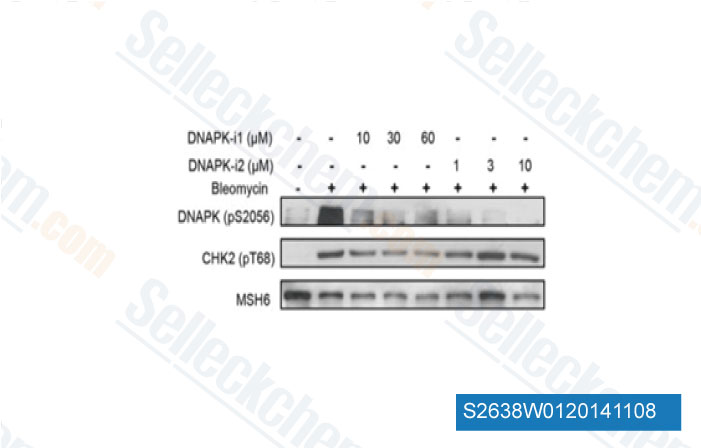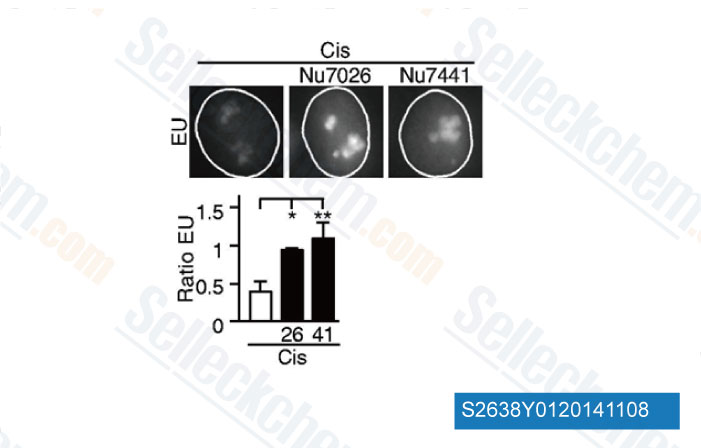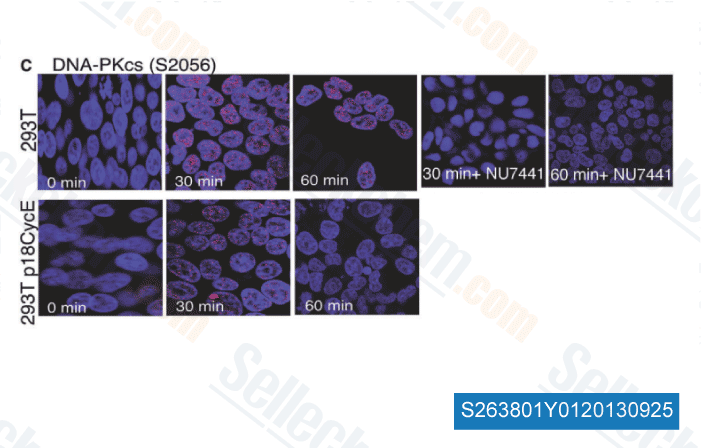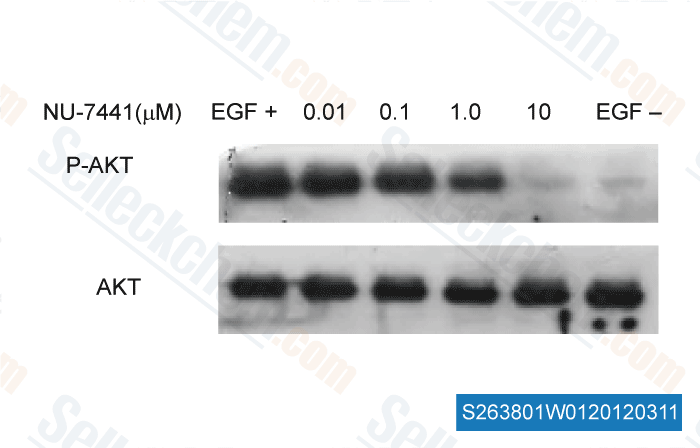|
Toll Free: (877) 796-6397 -- USA and Canada only -- |
Fax: +1-832-582-8590 Orders: +1-832-582-8158 |
Tech Support: +1-832-582-8158 Ext:3 Please provide your Order Number in the email. |
Technical Data
| Formula | C25H19NO3S |
|||
| Molecular Weight | 413.49 | CAS No. | 503468-95-9 | |
| Solubility (25°C)* | In vitro | DMSO | 15 mg/mL (36.27 mM) | |
| Water | Insoluble | |||
| Ethanol | Insoluble | |||
|
* <1 mg/ml means slightly soluble or insoluble. * Please note that Selleck tests the solubility of all compounds in-house, and the actual solubility may differ slightly from published values. This is normal and is due to slight batch-to-batch variations. * Room temperature shipping (Stability testing shows this product can be shipped without any cooling measures.) |
||||
Preparing Stock Solutions
Biological Activity
| Description | NU7441 (KU-57788) is a highly potent and selective DNA-PK inhibitor with IC50 of 14 nM and also inhibits mTOR and PI3K with IC50 of 1.7 μM and 5 μM in cell-free assays, respectively. It reduces the frequency of NHEJ while increasing the rate of HDR following Cas9-mediated DNA cleavage. | ||||||
|---|---|---|---|---|---|---|---|
| Targets |
|
||||||
| In vitro | NU7441 increases the persistence of γH2AX foci after ionizing radiation–induced DNA damage. NU7441 (0.5 μM or 1 μM) appreciably increases G2-M accumulation induced by ionizing radiation, and doxorubicin in both SW620 and LoVo cells. [2] NU7441 causes persistence of doxorubicin- and ionising radiation-induced DNA double-strand break and also slightly decreases homologous recombination activity DNA-PK-proficient M059-Fus-1 and DNA-PK-deficient M059 J human tumour cells. [3] NU7441 inhibits UV-induced RPA p34 hyperphosphorylation in a dose-dependent manner both in cells lacking and cells expressing polymerase η. [4] NU7441 increases levels of -induced γH2AX foci and correspondingly decreased -induced cell death in chronic lymphocytic leukemia cells. [5] NU7441 also inhibits -induced DNA-PKcs autophosphorylation and repair in chronic lymphocytic leukemia cells. [6] It reduces the frequency of NHEJ while increasing the rate of HDR following Cas9-mediated DNA cleavage[7]. |
||||||
| In vivo | NU7441 intraperitoneally administrated at dose of 10 mg/kg maintains for at least 4 hours shows nontoxic and increases induced tumor growth delay 2-fold in mice bearing SW620 xenografts. [2] |
Protocol (from reference)
| Cell Assay: |
|
|---|---|
| Animal Study: |
|
References
Customer Product Validation

-
Data from [Data independently produced by Toxicol Sci, 2014, 10.1093/toxsci/kfu207]

-
Data from [Data independently produced by Nucleic Acids Res, 2013, 41(15), 7378-86]

-
Data from [Nucleic Acids Res, 2013, 41, 10157-69]

-
, , Dr. Zhang of Tianjin Medical University
Selleck's NU7441 (KU-57788) has been cited by 299 publications
| Homologous recombination promotes non-immunogenic mitotic cell death upon DNA damage [ Nat Cell Biol, 2025, 27(1):59-72] | PubMed: 39805921 |
| Phosphorylation-dependent WRN-RPA interaction promotes recovery of stalled forks at secondary DNA structure [ Nat Commun, 2025, 16(1):997] | PubMed: 39870632 |
| Extracellular Mitochondria Exacerbate Retinal Pigment Epithelium Degeneration in Diabetic Retinopathy [ Diabetes, 2025, 74(3):409-415] | PubMed: 39715576 |
| Vitrification affects the post-implantation development of mouse embryos by inducing DNA damage and epigenetic modifications [ Clin Epigenetics, 2025, 17(1):20] | PubMed: 39920865 |
| Transcription-coupled DNA-protein crosslink repair by CSB and CRL4CSA-mediated degradation [ Nat Cell Biol, 2024, 10.1038/s41556-024-01394-y] | PubMed: 38600236 |
| Distinct regulation of ATM signaling by DNA single-strand breaks and APE1 [ Nat Commun, 2024, 15(1):6517] | PubMed: 39112456 |
| The Fanconi anemia core complex promotes CtIP-dependent end resection to drive homologous recombination at DNA double-strand breaks [ Nat Commun, 2024, 15(1):7076] | PubMed: 39152113 |
| Comprehensive multi-omics analysis reveals WEE1 as a synergistic lethal target with hyperthermia through CDK1 super-activation [ Nat Commun, 2024, 15(1):2089] | PubMed: 38453961 |
| DNA-PK inhibition enhances neoantigen diversity and increases T cell responses to immunoresistant tumors [ J Clin Invest, 2024, e180278] | PubMed: 39436696 |
| Kaposi's sarcoma herpesvirus exploits the DNA damage response to circularize its genome [ Nucleic Acids Res, 2024, gkad1224] | PubMed: 38180827 |
RETURN POLICY
Selleck Chemical’s Unconditional Return Policy ensures a smooth online shopping experience for our customers. If you are in any way unsatisfied with your purchase, you may return any item(s) within 7 days of receiving it. In the event of product quality issues, either protocol related or product related problems, you may return any item(s) within 365 days from the original purchase date. Please follow the instructions below when returning products.
SHIPPING AND STORAGE
Selleck products are transported at room temperature. If you receive the product at room temperature, please rest assured, the Selleck Quality Inspection Department has conducted experiments to verify that the normal temperature placement of one month will not affect the biological activity of powder products. After collecting, please store the product according to the requirements described in the datasheet. Most Selleck products are stable under the recommended conditions.
NOT FOR HUMAN, VETERINARY DIAGNOSTIC OR THERAPEUTIC USE.
